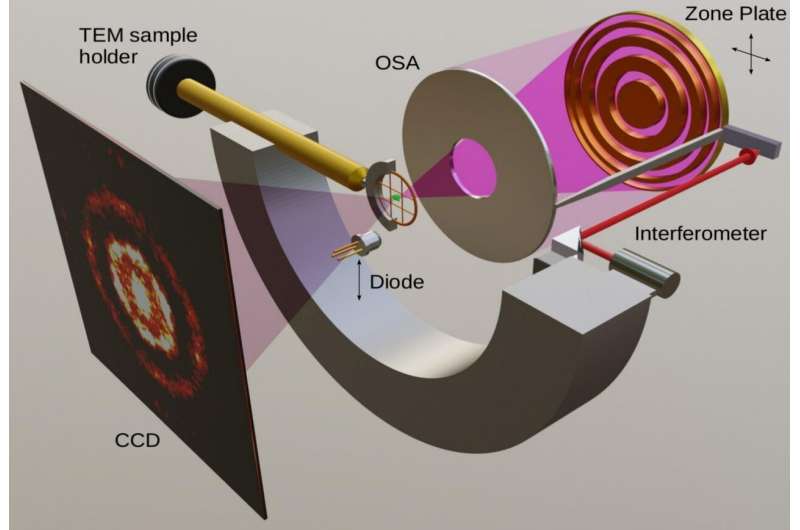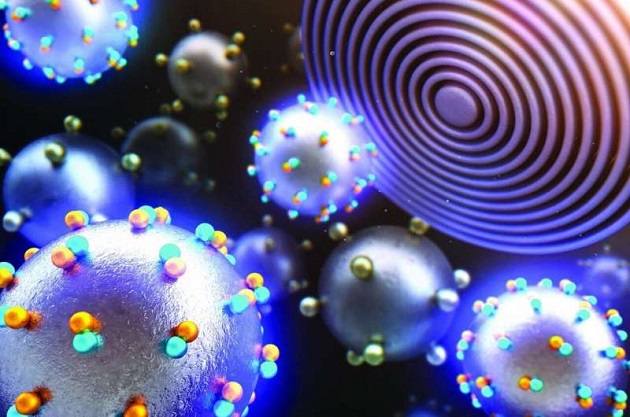COSMIC, a multipurpose X-ray instrument at Lawrence Berkeley National Laboratory’s (Berkeley Lab’s) Advanced Light Source (ALS), has made headway in the scientific community since its launch less than 2 years ago, with groundbreaking contributions in fields ranging from batteries to biominerals.
COSMIC is the brightest X-ray beamline at the ALS, a synchrotron that generates intense light—from infrared to X-rays—and delivers it to dozens of beamlines to carry out a range of simultaneous science experiments. COSMIC’s name is derived from coherent scattering and microscopy, which are two overarching X-ray techniques it is designed to carry out.
Its capabilities include world-leading soft X-ray microscopy resolution below 10 nanometers (billionths of a meter), extreme chemical sensitivity, ultrafast scanning speed as well as the ability to measure nanoscale chemical changes in samples in real time, and to facilitate the exploration of samples with a combination of X-ray and electron microscopy. Soft X-rays represent a low range in X-ray energies, while hard X-rays are higher in energy. Each type can address a different range of experiments.
COSMIC is setting the stage for a long-term project to upgrade the decades-old ALS. The effort, known as the ALS Upgrade (ALS-U), will replace most of the existing accelerator components with state-of-the-art technology, ensuring capabilities that will enable world-leading soft X-ray science for years to come. The upgrade will also further enhance COSMIC’s ability to capture nanoscale details in the structure and chemistry of a broad range of samples.
The expected 100-fold increase in X-ray brightness that ALS-U will deliver will provide a similar increase in imaging speed at COSMIC, and a more than threefold improvement in imaging resolution, enabling microscopy with single-nanometer resolution. Further, the technologies being developed now at COSMIC will be deployed at other beamlines at the upgraded ALS, making possible microscopy with higher X-ray energies for many more experiments. The instrument is one of many highly specialized resources available to scientists from around the world for free through a peer-reviewed proposal process.
Another journal article, published Jan. 19, 2021), in Proceedings of the National Academy of Sciences, demonstrated the first-ever use of X-ray linear dichroic ptychography, a specialized high-resolution imaging technique available at COSMIC, to map the orientations of a crystal known as aragonite that is present in coral skeletons at 35-nanometer resolution. The technique shows promise for mapping other biomineral samples at high resolution and in 3-D, which will provide new insights into their unique attributes and how to mimic and control them. Some biominerals have inspired humanmade materials and nanomaterials due to their strength, resilience, and other desirable properties.
“We use this user-friendly, unique platform for materials characterization to demonstrate world-leading spatial resolution, in conjunction with operando and cryogenic microscopy,” said David Shapiro, the paper’s lead author and the lead scientist for COSMIC’s microscopy experiments. He also leads the ALS Microscopy Program. “Operando” describes the ability to measure changes in samples as they are occurring.
COSMIC contributors included members of Berkeley Lab’s CAMERA (Center for Advanced Mathematics for Energy Research Applications) team, which includes computer scientists, software engineers, applied mathematicians, and others; information technology experts; detector specialists; engineers; scientists at the Molecular Foundry’s National Center for Electron Microscopy; ALS scientists; and outside collaborators from the National Science Foundation’s STROBE Science and Technology Center and Stanford University.
Several advanced technologies developed by different groups were integrated into this one instrument. Key to the demonstrations at COSMIC reported in the paper is the implementation of X-ray ptychography, which is a computer-aided image reconstruction technique that can exceed the resolution of conventional techniques by up to about 10 times.
Instead of relying on imperfect optics, ptychography records a large number of physically overlapping diffraction patterns—which are images produced as X-ray light scatters from the sample—each offering a small piece of the full picture. Rather than being limited by optics quality, the ptychography technique is limited by the brightness of the X-ray source—precisely the parameter that ALS-U is expected to improve a hundredfold. To capture and process the enormous amount of data and reconstruct the final image requires data processing facilities, computer algorithms, and specialized fast pixel detectors like those developed at Berkeley Lab.

“X-ray ptychography is a detector-enabled technique—first deployed with hard (high-energy) X-rays using hybrid pixel detectors, and then at the ALS with the FastCCD we developed,” said Peter Denes, the ALS detector program lead who worked with lead engineer John Joseph on the implementation at COSMIC. “Much of the COSMIC technology benefited from the Laboratory Directed Research and Development (LDRD) Program, as did the FastCCD, which translated tools for cosmology into COSMIC observations.” Berkeley Lab’s LDRD Program supports innovative research activities that keep the Lab at the forefront of science and technology.
Ptychography utilizes a sequence of scattering patterns, produced as X-ray light scatters from a sample. These scattering patterns are analyzed by a computer running high-performance algorithms, which convert them into a high-resolution image.
The ALS Upgrade will further drive its data demands up to an expected 100 terabytes per day, Shapiro noted. Plans are already being discussed for using more resources at Berkeley Lab’s National Energy Research Scientific Computing Center (NERSC) to accommodate this pending ramp-up in data.
COSMIC is a stellar example of Berkeley Lab’s Superfacility Project, which is designed to link light sources like the ALS and cutting-edge instrumentation including microscopes and telescopes with data and high-performance computing resources in real time, said Bjoern Enders, a data science workflows architect in NERSC’s Data Science Engagement Group.
COSMIC started up in commissioning mode in March 2017, and opened to general scientific experiments about 2 years ago. Since this time, instrument staff have launched the operando capabilities that measure active chemical processes, for example, and rolled out linear and circular dichroic microscopy and tomography capabilities that further extend COSMIC’s range of imaging experiments.
Its coherent scattering branch is now undergoing testing and is not yet available to external users. Work is also in progress to correlate its X-ray microscopy results with electron microscopy results for active processes, and to further develop its cryogenic capabilities, which will allow biological samples and other soft materials to be protected from damage by the ultrabright X-ray beam while they are being imaged. The combination of X-ray and electron microscopy can provide a powerful tool for gathering detailed chemical and structural information on samples, as demonstrated in an experiment involving COSMIC that was highlighted in the journal Science Advances.








